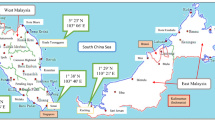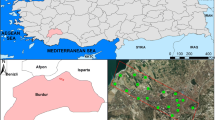Abstract
In this study, a simple methodology is proposed to estimate ambient temperature bin data. The proposed model is based on the determination of the best fitting equation describing the characteristics of the cumulative frequency distribution of yearly bin weather data values. This approach makes it easy for anyone, who needs bin data values for any location, to adopt the fitted equations in the building energy performance calculations. A case study was applied to six cities in Turkey, and the applicability of the proposed model has been shown. The obtained R2 values of the fitted equations are higher than 0.99. Therefore, the coefficients of the fitted equations for any location can be used easily to predict any bin data value to be used in building energy performance calculations. The results of this study are important for the experts using bin method.









Similar content being viewed by others
References
Al-Homoud, M. S. (2001). Computer-aided building energy analysis techniques. Building and Environment, 36(4), 421–433.
ASHRAE. (1995). Bin and Degree hour weather data for simplified energy calculations. Atlanta: American Society of Heating, Refrigerating and Air-Conditioning Engineers, Inc.
Auffhammer, M., & Aroonruengsawat, A. (2011). Simulating the impacts of climate change, prices and population on California’s residential electricity consumption. Climatic Change, 109(Supplement 1), 191–210.
Borge-Diez, D., Colmenar-Santos, A., Pérez-Molina, C., & López-Rey, A. (2015). Geothermal source heat pumps under energy services companies finance scheme to increase energy efficiency and production in stockbreeding facilities. Energy, 88, 821–836.
Brown, M. A., Cox, M., Staver, B., & Baer, P. (2016). Modeling climate-driven changes in U.S. buildings energy demand. Climatic Change, 134(1–2), 29–44.
Bulut, H., & Aktacir, M. A. (2011). Determination of free cooling potential: a case study for İstanbul, Turkey. Applied Energy, 88(3), 680–689.
Bulut, H., Büyükalaca, O., & Yılmaz, T. (2001). Bin weather data for Turkey. Applied Energy, 70(2), 135–155.
Bulut, H., Büyükalaca, O., & Yılmaz, T. (2003). New outdoor heating design data for Turkey. Energy, 28(12), 1133–1150.
Butler, D. (2008). Architects of a low-energy future. Nature, 452(3), 520–533.
Degelmen, L. O. (1985). Bin weather data for simplified energy calculations and variable degree-day information. ASHRAE Transactions, 91(1A), 3–14.
Fazeli, R., Ruth, M., & Davidsdottir, B. (2016). Temperature response functions for residential energy demand—a review of models. Urban Climate, 15, 45–59.
Iwaro, J., & Mwasha, A. (2010). A review of building energy regulation and policy for energy conservation in developing countries. Energy Policy, 38(12), 7744–7755.
Jin, Z., Yezheng, W., & Gang, Y. (2006). A stochastic method to generate bin weather data in Nanjing, China. Energy Conversion and Management, 47(13–14), 1843–1850.
Koulamas, C., Kalogeras, A. P., Pacheco-Torres, R., Casillas, J., & Ferrarini, L. (2018). Suitability analysis of modeling and assessment approaches in energy efficiency in buildings. Energy and Buildings, 158, 1662–1682.
Kreider, J. F., & Rabl, A. (1994). Heating and cooling of buildings: Design for efficiency. New York: McGraw Hill.
Li, Z., Han, Y., & Xu, P. (2014). Methods for benchmarking building energy consumption against its past or intended performance: an overview. Applied Energy, 124, 325–334.
Meng, Q., & Mourshed, M. (2017). Degree-day based non-domestic building energy analytics and modelling should use building and type specific base temperatures. Energy and Buildings, 155, 260–268.
Özyurt, Ö., Bakirci, K., Erdoğan, S., & Yilmaz, M. (2009). Bin weather data for the provinces of the Eastern Anatolia in Turkey. Renewable Energy, 34(5), 1319–1332.
Papakostas, K. T., & Sotiropoulos, B. A. (1997). Bin weather data of Thessaloniki, Greece. Renewable Energy, 11(1), 69–76.
Papakostas, K., Bentoulis, A., Bakas, V., & Kyriakis, N. (2007). Estimation of ambient temperature bin data from monthly average temperatures and solar clearness index. Validation of the methodology in two Greek cities. Renewable Energy, 32(6), 991–1005.
Papakostas, K., Tsilingiridis, G., & Kyriakis, N. (2008). Bin weather data for 38 Greek cities. Applied Energy, 85(10), 1015–1025.
Peng, Z., Jin, Z., Guoqiang, Z., & Yezheng, W. (2009). Generation of ambient temperature bin data of 26 cities in China. Energy Conversion and Management, 50(3), 543–553.
Perez-Lombard, L., Ortiz, J., & Pout, C. (2008). A review on buildings energy consumption information. Energy Building, 40(3), 394–408.
Pusat, S., & Ekmekci, İ. (2017). Bin weather data for different climates of Turkey. International Journal of Global Warming, 12(1), 85–98.
Pusat, S., Ekmekçi, İ., & Akkoyunlu, M. T. (2015). Generation of typical meteorological year for different climates of Turkey. Renewable Energy, 75, 144–151.
Saidur, R. (2009). Energy consumption, energy savings, and emission analysis in Malaysian office buildings. Energy Policy, 37(10), 4104–4113.
Schicktanz, M. D., Döll, J., & Fugmann, H. (2014). Calculation of solar gains for solar heating and cooling using the bin-method. Energy Procedia, 48, 1665–1675.
Üner, M., & İleri, A. (2000). Typical weather data of main Turkish cities for energy applications. International Journal of Energy Research, 24(8), 727–748.
Vine, E. (2003). Opportunities for promoting energy efficiency in buildings as an air quality compliance approach. Energy, 28(4), 319–341.
Wang, Z., Ding, Y., Geng, G., & Zhu, N. (2014). Analysis of energy efficiency retrofit schemes for heating, ventilating and air-conditioning systems in existing office buildings based on the modified bin method. Energy Conversion and Management, 77, 233–242.
Author information
Authors and Affiliations
Corresponding author
Ethics declarations
Conflict of interest
The author declares that he has no conflict of interest.
Rights and permissions
About this article
Cite this article
Pusat, S. A simple approach to estimate ambient temperature bin data. Energy Efficiency 12, 1053–1064 (2019). https://doi.org/10.1007/s12053-018-9717-6
Received:
Accepted:
Published:
Issue Date:
DOI: https://doi.org/10.1007/s12053-018-9717-6




